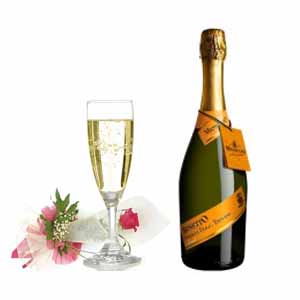5 Common Names For Champagne

If you have ever experienced confusion or frustration when shopping for champagne, it may be because you do not recognize all the different names that are used to describe champagne. This is one of the most challenging aspects of learning about wine – the different names that are used to describe a varietal. Here learn five common names used for champagne and be on your way to shopping for bubbly with confidence!

While you are learning about champagne, as you read more you may realize that “champagne” is actually a name that derives from the principle region in which the grapes used to make this sparkling white wine are produced. Like “pop” or “soda” for non-alcoholic carbonated beverages, “champagne” is often used to describe any sparkling or “bubbly” wine. In actuality, a sparkling or champagne wine is typically created from a blend of pinot noir, chardonnay and pinot meunier grapes.
Any wine that bears the actual label of “champagne” contains grapes grown in the Champagne region of France. There are three main types of French champagne.
Just as champagne hails from France, prosecco hails exclusively from Italy. The prosecco varietal is actually a sparkling white wine made of Glera, pinot grigio and pinot bianco grapes. Prosecco tastes best when served young (three years old is considered “aged”) and very chilled. Prosecco often comes with descriptive labels such as “dry” or “extra dry.” The less dry the prosecco is the sweeter its taste will be.
Sparkling wine is a white sparkling vintage that tends towards either a sweet or dry taste with refreshing fruit tones. Sparkling wine is the most common wine served for “toasts.” Sparkling wine can include a number of grape types. Sparkling wine itself actually was created in the United States in New York.
Sparkling rose (pronounced “rose-aye”) wine is produced using a variety of fermentation and distillation techniques. As well, sparkling rose grapes come from all over the world and most notably from the United States in the Napa Valley and Sonoma regions. Contact with the skins of red grapes gives sparkling rose wines their distinctive “blush” tones.
You may be more familiar with rose champagne by the name “pink champagne.” This particularly festive champagne varietal gets its distinctive pigmentation from a fermentation process that includes the skins of red grapes – a technique called “maceration.” As with sparkling rose wine, here, “rose” is pronounced “rose-aye.” As with white French champagne, all true rose champagne hails from the Champagne region in France.
Now that you have a helpful primer to distinguish between different names for the sparkling wine most commonly referred to as “champagne,” you can pick the perfect varietal for your next toast, party or special occasion.
About the Author: Shawn Jeffries visits http://citywinecellar.com/ each spring and fall to select his favorite wines and champagnes. He loves hosting wine tasting parties to introduce friends to his favorite varietals.
